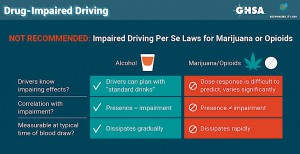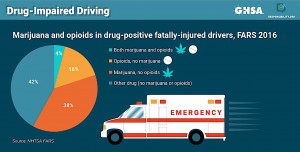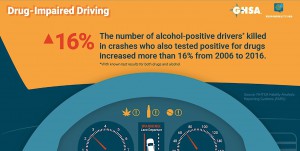“Drug Driving is Drunk Driving,” or so declares the electronic road signs found along many Michigan roads in recent months.
In recent decades, authorities have aggressively cracked down on drinking and driving, but a new study by the Governors Highway Safety Association warns that a new danger may be facing travelers: rising use of opioids and marijuana, often in combinations that include alcohol.
Where tests were performed, 44% of drivers fatally injured in a crash tested positive for drugs in 2016, up from 28% a decade earlier. Of those who tested positive for drugs in the latest study, 38% had used marijuana, 16% had used some form of opioid, and 4% tested positive for a combination of both.
Those figures may understate the potential problem, according to the GHSA, because the majority of drivers killed in crashes don’t undergo drug tests. But when they do, they’re often found to have been using alcohol, as well, according to Dr. Jim Hedlund, the author of the GHSA report and a former senior official with the National Highway Traffic Safety Administration.
(Gas prices level off as summer driving season starts. Click Here for the story.)
As a result of inconsistent testing, said Hedlund, “It’s impossible to understand the full scope of the drugged driving problem.” But he stressed that, “Drugs can impair, and drug-impaired drivers can crash.”
The report raises serious concerns at a time when the U.S. is facing an epidemic of opioid usage and as more and more states legalize marijuana for medical and recreational usage. But the authors were also raised several caution flags. Just as it is considered safe and legal to drink a modest amount of alcohol before driving, Hedlund added that, “Drivers who are drug-positive may not necessarily be impaired.” And it is unclear how often the use of drugs actually contributed to fatal crashes.
What is known is that alcohol continues to be a problem. Not that many decades ago, it was linked to as much as half of all fatal car crashes in the U.S., It was still considered a primary factor in 28% of traffic fatalities in 2016. Now, “we have to think about the combination of substances drivers are often putting into their systems at the same time,” said Ralph Blackman, president and CEO of Responsibility.org, a Virginia-based non-profit focused on drunk driving.
Drug driving is not a uniquely American phenomenon. Belgian authorities last December reported that three-quarters of the country’s motorists who admitted using drugs while driving had also used alcohol. And at a Madrid seminar this month sponsored by the European Transport Safety Council, Spanish authorities reported that 12% of that country’s motorists had admitted driving under the influence of drugs at some point. Overall, drug driving was estimated to be responsible for as much as 8% of driver fatalities in the European Union.
(Click Here for more about how dealers are hampering EV sales.)
“Adding to these concerns is the frequency of poly-drug use, or the use of multiple potentially-impairing substances simultaneously,” the GHSA noted in a summary of its new drug driving study. “In 2016, 51% of drug-positive fatally-injured drivers were found positive for two or more drugs. Alcohol is often in the mix as well: 49% of drivers killed in crashes who tested positive for alcohol in 2016 also tested positive for drugs.
The organization is calling for a number of steps to address the potential drug driving problem:
- The development of new tests meant to determine when a motorist is impaired by the use of drugs;
- The expansion of public awareness campaigns that focus on changing attitudes about driving while using drugs;
- Increased prosecution of those found to be driving while impaired by drug use.
“Too many people operate under the false belief that marijuana or opioids don’t impair their ability to drive, or even that these drugs make them safer drivers,” said GHSA Executive Director Jonathan Adkins.
One problem is that, unlike with the use of alcohol, it is far less clear when and how much marijuana or opioids can be used while driving. For example, THC, the active ingredient in cannabis, remains in the blood for an extended period, even after a user is no longer high.
“Research has demonstrated the potential of marijuana to impair driving-related skills,” NHTSA advised Congress in a report last July, but the safety agency also raised several caution flags. It said that it can be difficult determining when a driver using marijuana is unfit to be behind the wheel. And it also questioned the accuracy of tests used to determine if – or how much – THC is in the blood.
“Many studies, using a variety of methods, have attempted to estimate the risk of driving after use of marijuana,” the NHTSA report said. “While useful in identifying how marijuana affects the performance of driving tasks, experimental and observational studies do not lend themselves to predicting real-world crash risk.”
Indeed, several studies conducted since the first states began legalizing recreational use of marijuana have generated conflicting results. One, by the University of Colorado, and released in 2014, showed a surge in fatalities involving stoned drivers. But a NHTSA study conducted in Virginia a year later found no clear increase in risk.
(To see more about how U.S. new vehicle sales are blooming in May, Click Here.)
The GHSA study clearly indicates that more research is necessary, while a mix of education and prosecution could be used to prevent a potential problem from growing worse.




No one should drive impaired, but actual impairment should be measured, and the level of impairment from cannabis that is criminalized should be the same as the level of impairment for the blood alcohol limit. I have developed a new public health app that is a general measure of impairment from cannabis or any source–anything that impairs reaction time, hand-eye coordination, balance and the ability to perform divided attention tasks–it is called DRUID (an acronym for “DRiving Under the Influence of Drugs”) available now in the App Store and in Google Play. DRUID measures reaction time, decision making, hand-eye coordination, time estimation and balance, and then statistically integrates hundreds of data points into an overall impairment score. DRUID takes just 2 minutes.
NORML of California is promoting DRUID on their website and is encouraging cannabis users to download it.
Our website is http://www.druidapp.com
DRUID allows cannabis users (or others who drink alcohol, use prescription drugs, etc.) to self-assess their own level of impairment and (hopefully) decide against driving if they are impaired. Prior to DRUID, there was no way for an individual to accurately assess their own level of impairment.
DRUID was featured DRUID was featured in Wired magazine: https://www.wired.com/story/portable-field-sobriety-tests/
on NPR’s All Things Considered: http://www.npr.org/2017/01/25/511595978/can-sobriety-tests-weed-out-drivers-whove-smoked-too-much-weed
Also on television: http://sacramento.cbslocal.com/2017/02/28/science-lags-behind-marijuana-impairment-testing/
And this past December on Spokane Public Radio: http://nwpr.org/post/progress-made-marijuana-intoxication-measurement-tool-0
After obtaining my Ph.D. at Harvard, I have been a professor of psychology at UMass/Boston for the past 40 years, specializing in research methods, measurement and statistics.
Michael Milburn, Professor
Department of Psychology
UMass/Boston
___________________________________________________________________________________
https://www.leafly.com/news/politics/dui-101-why-per-se-laws-work-for-alcohol-but-not-cannabis
“ If we want to get serious about measuring impairment we will need to move to devices that gauge impairment by testing cognitive and physical functionality, along the lines of the DRUID app”
Ian Mitchell–Ian Mitchell is an Associate Professor of Emergency Medicine at the University of British Columbia. He is the qualified investigator for a randomized controlled trail of vaporized cannabis for PTSD and a contributing editor for the Using Medical Cannabis journal. Follow him on LinkedIn or on Twitter @travels2little.